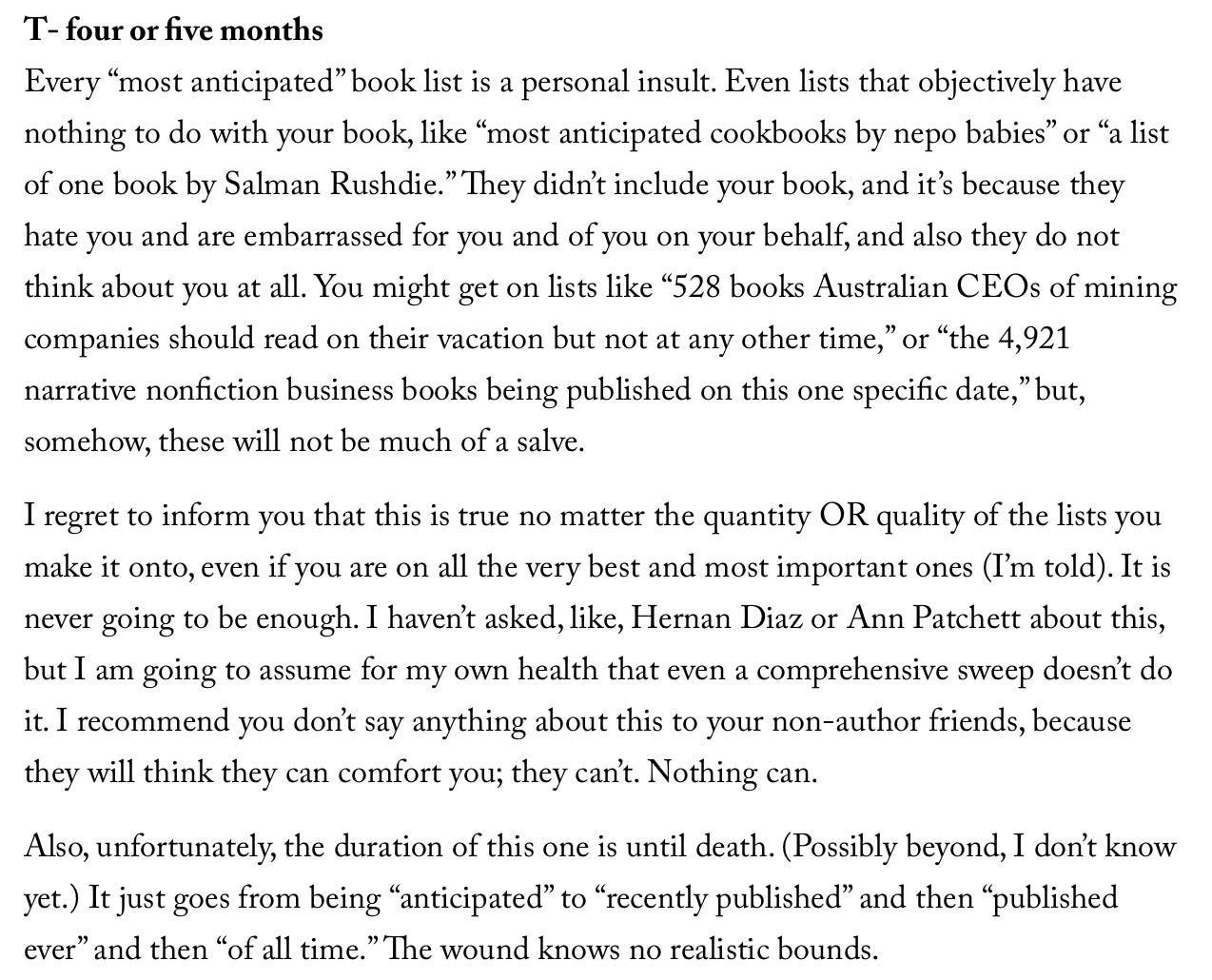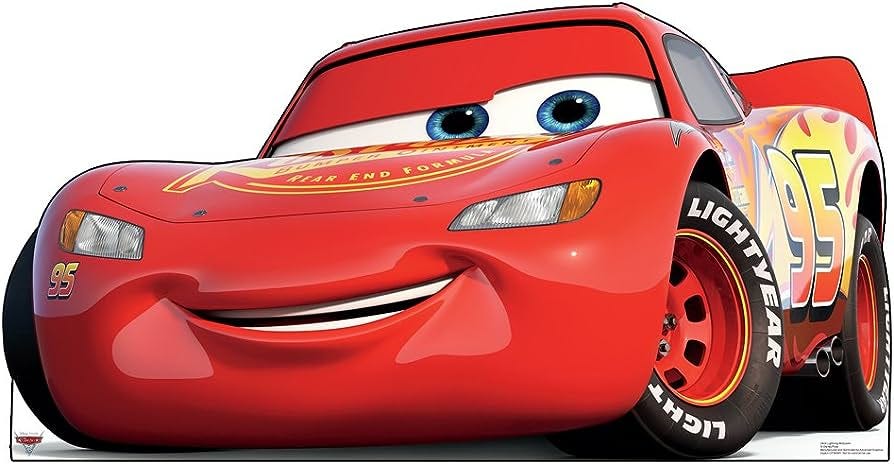Alright y’all, when my child has a meltdown, we do some hugging & some deep breathing, a little Kumbaya. I’m going to need y’all to get on that train before I tell you what I’m about to tell you.
That end of year list you're desperate to be on, or that anticipated book list that will round the corners of the internet in a few short weeks, are based on a few factors—none of which you have any control over.
Publicists have no control over these lists. Love you so much. Publicists cannot pitch “an anticipated list” specifically. Love you to the moon. You will not find yourself on a list somewhere where your book was not reviewed or featured. Sweet, sweet, lovable you.
When a writer tells me they want to appear on all the anticipated lists (I love a challenge) but all I can do is what I would do anyway, pitch the book out.
Media is using the books on that mega-list to drive traffic, you guessed it, back to them. So, the more links they can include to previous features, reviews, and interviews, the more they’re going to do that as part of their lists.
It’s a fraught time.
Here’s how you can help:
Even the writers of the lists acknowledge the lists aren’t worth acknowledging (except their list of course).
Mary Childs’ gets it totally right in this Literary Hub piece about her book launch.
Here’s who isn’t reading your Twitter recommendations when you respond to these posts (companies! corporate conglomerates!), but they do know that these sorts of posts garner a lot of attention on social media and so widens their audience and reaches more people. And how you can help your friends is by liking their responses to these posts so it seems like everyone is really into their book (and they probably are!)
And the lists that everyone loves on Electric Literature and The Rumpus “What to Read When” are recommended by real, actual people, usually writers who are doing lists as part of the publicity for their own book, and thus those lists only represent the books that they’ve read and loved. The scope is limited to that one mind and whatever they can Google if they can’t come up with approximately eight books in that category. So, if your book isn’t on the “best books for folks who love the bickering on House Hunters International,” and yet your book is literally an interview series with couples who divorced over their experience on House Hunters International, it’s not an affront to you, it’s that they simply didn’t read your book.
And in full transparency, if X (formerly known as Twitter) didn’t exist, I think these lists would die out too, or at least the magazines that really cared about them would feature them in print. The power of the list holds because we all can see in real time the authors who made the lists tweeting, “oh my gosh! I can’t believe…” or “oh my gosh, so thankful for [insert major news source] chose [insert book title]. I like every single one of these tweets, guilty! But when scrolling it feels a little bit like Taylor Swift’s surprise face or Miss America accepting her crown. These lists, well, they drive traffic through quote tweets and reposts and shares and story features and TikTok analysis—INTERACTIONS. So, algorithm.
So, here’s how the lists are made:
ALGORITHMS: You’ll see a lot of lists based on (Amazon) rankings and sales. Bookmarks is a really awesome part of Literary Hub, especially for a publicist like me, but they’re also feeding these book lists because editors can go in and see what the best reviewed books of every week are, or top reviewed books of the year. Essentially, what books appeared the most across the World Wide Web or already got the best reviews. And Booklist has standards (reviews have to be from certain places in a certain time span) and so your book is only included on Bookmarks if it’s already reached a publicity benchmark.
MONEY: So, tale as old as time, the more money put behind the marketing of the book, *typically* the more often you’ll see it on the lists. This includes: the original advance paid to the author, the aesthetics of the book, the publicity timeline (did they give it a really long run so they can pitch Jenna’s Book Club?), the print run, the “lead title” factor, the “in-house favorite” factor, if it’s presented to the sales team & sales reps (does the press have a sales team or sales reps), how early galleys are ready, how many physical galleys they’re sending out, etc. This is not to say that those books are not worth the price paid for them, but they are a self-fulfilling prophecy.
Who has the money? Big four (conglomerate and endowment) publishers.
Because they have money, they have time. And what I mean by that is that they can start pitching a book to sales reps in sales meetings several seasons before an independent press can get books into that part of the publication process. University presses, it depends on the press and the speed at which they work. It also depends on distribution. So, money=time. Money=people power (or the folks they can assign to your book, whether they have a publicity and/or marketing department). Cash!
Who has the money? Celebrity memoirs.
(You know who I haven’t seen on any lists even though she’s been reviewed everywhere, Caroline Calloway. You know who is on a few lists? Natalie Beach. Interesting that Natalie published with a big four and Caroline is an influencer who self-published).
Who has the money? People paying for an outside publicist who has the time and energy to get a little momentum behind their book. Kachow!
CRITIC & CONTRIBUTOR CHOICES: Lists from places like Vulture or NPR or Times Literary Supplement are provided by asking critics and contributors. Actual people of media on their favorite reads. These lists are arguably a little bit more exciting (in terms of the breadth and depth of book choices beyond algorithm and money) because a critic could have read and loved a university press title or a small press book or a poetry collection, and is able to tell readers why it’s their personal favorite and deserves to be on this list. I like imagining all the critics around a little table fighting it out like the finale of Project Runway when they have to choose models.
OTHER ONGOING FACTORS:
—the first spoke is what I like to call “the beloveds” aka name recognition. It’s why on every anticipated list of 2024 (depending on audience) you’ll see the following names: Jami Attenderg, Leslie Jamison, Jane Smiley, Ruth Reichl, Hanif Abdurraqib, Téa Obreht, Emily Henry, Kiley Reid, and Kelly Link. Well-loved authors we already know with new books. These are career authors or authors on their way to being career authors.
—the second spoke is what I’ll call “hot buttons” or books that have somehow perfectly arrived at the right moment in time to be considered “timely.” Sometimes larger publishers can rush these books (re: timely nonfiction or what editor Aubrey Martinson at Crown says, “sparks change and conversation”), but usually this is the luck of right place, right time. Because publishing is a slow-living endeavor—from signing to publication is usually 2+ years, it’s hard to hit buzz when buzz is happening. This is bigger than I’m a woman and my book is publishing during Women’s History Month, or the fact that a ton of poetry collections come out around AWP and National Poetry Month, it’s rather a book that makes her appearance during a larger conversation we’re having as a general populous of readers. And sometimes the opposite happens to a book where the global conversation or the culture block isn’t open to a certain perspective, take, theory, or theme at that time. (This part can be really shitty).
Books I like to think of when I think of “hot button” books are yes, political or hefty nonfiction, but they can also be literary (and please note, these books are fantastic, they just also had great timing):
Jia Tolentino’s Trick Mirror, which arrived right when we were starting to question Instagram filters and the Kardashian chokehold.
Every book on burnout in the last few years, but especially Essential Labor by Angela Garbes which hit shelves right when we were coming out of the pandemic and starting to have deep conversations about family structures, mothering, care work, the economy, and undervalued work across America (union of mothers!)
Wintering by Katherine May, called “the runaway New York Times bestseller,” but also a comforting pandemic-adjacent book about fallow periods, illness, and life’s hardship.
—the third spoke is hot girl books, by which I mean you would be a hot girl if you were seen reading this book. There is quite literally a Goodreads list that’s pretty accurate. Hot girl books have hot girl covers, not blobs, amalgams, or some sort of unlabeled shape. They like funky or vintage fonts, art housed at The Met—both paintings of women and still life of fruit, bold & bright coloring OR shadowy + pastels, a body part or a face—all I can really say is you know them when you see them. They feel like an argumentative response to the label “women’s fiction” or the pastel pink of 90s chick lit. They're designed with hot girls in mind for hot girl walks and hot girl lounge chairs and hot girl tiny white porcelain cups and punchy nail colors and aesthetic coffee shop bookstagram photos.
My Year of Rest and Relaxation by Otessa Moshfegh is a perfect example.
—the fourth is not true for every list, but it’s ageism. The 5 under 35 folks say out loud what the other lists reveal in a scroll. If you’re not already a career or beloved author, or you’re not a leader in your field (scientist, technologist, CEO, business person), and your debuting at a later age, it might be hard to get on some lists unless you are the “elder” book of the season (Mitch Albom, even Sigrid Nunez who had an ENTIRE CAREER before The Friend). And there are a lot of reasons at play here, but there’s so much turnover in media, folks aren’t staying in these editorial (or intern!) roles building book lists, so they’re often edited by young, early-career people picking books that speak to the moment of their lives. (True too, for editorial).
—the fifth is be a niche category standout. You wrote THE momoir of the year. (Yes, I’m making it a thing! mom-oir! So chic! So in! So full of rage!). You wrote the best retirement book of the year (check out my girl, Abigail Thomas on this list for Wall Street Journal). Your book is perfect for gift guides, for dads or boyfriends (see Brian Allen Carr’s Bad Foundations), for divorcees in the season of divorce, then perhaps you will be THE book on the list of 100 books because you stood out in your category.
Yes, identity matters here too.
—the sixth, you got a star. Like the early aughts when we had star charts and sticker chores and highlights sent out sticker sheets with their magazine, you, darling, are a star. Kirkus or Library Journal or Booklist or Publishers Weekly has said so. The stars do make folks pay attention.
GOSSIP GIRL FACTORS: This is the fun part, and the only part arguably that a publicist has a chance of pursuing.
You, by a little sprinkle of stardust (and a really great pitch, thank you, I am clapping for myself) tap into the right editor or critic or contributor or Tiktoker or influencer, at the right time (season!) in the right moment of their day (right after lunch or late afternoon) with your secret little book that hasn’t been picked up anywhere and that tiny, brief, bumblebee buzz you hear coming in hot behind you avalanches into the kind of momentum that makes other people listen. Your book is the Dan Humphrey of books, creating a little xoxo wherever it goes. Somehow, your book that wasn’t gaining the kind of steam you were hoping for, is sending requests straight to you or your publicist’s email. It doesn’t happen often, but it happens enough.
I would love for Penn Badgeley to write recommended book lists for every character he has ever played, including himself because I believe he reads.
—
So, in summary. Publicists have no control over lists. You have no control over lists. The long “most anticipated” and year end lists (longer than ten books) don’t sell books. So, give yourself the gift of crossing lists off your list this year. You deserve it.
As always, the Pine State calendar of events lives here. Request books for review & interview & feature here, add yourself to our reviewer list here, and buy our books here! You can also contact us through our website, Pinestatepublicity.com.
ICYMI: You can read two (one at Literary Hub and one at The Pennsylvania Gazette) excerpts from Beth Kephart’s My Life in Paper: Adventures in Ephemera this week, Amy Bobeda interviewed Jessica E. Johnson at Full Stop about her collection, Metabolics, Sean Enfield wrote about going between poetry and prose on Write More, Be Less Careful, Jehanne Dubrow’s Exhibitions: Essays on Art and Atrocity was reviewed in On the Seawall, Susan Ito was interviewed about the adoptee experience and I Would Meet You Anywhere in Shondaland, Tatiana Johnson-Boria is the November poet at Academy of American Poets, read her interview here, Margo Steines wrote about her three favorite books of 2023 (including Kelly McMaster’s The Leaving Season), Susan Ito’s book was a November book pick for GMA / ABC News, she also blessed us with an Oldster Mag interview, Debutiful named Kate Doyle’s I Meant It Once as a best book of 2023, Holly M. Wendt wrote about managing a large list of characters for Writers Digest, and so much more on our Twitter & Instagram.













Well, this takes all the sting out of not making a list. Maybe you publicists should start your own list, but with a hitch. You can't put any of of the books you represent on your list. Then post 10 different publicists lists. Anyway, I enjoyed the read and your sense of humor about the whole thing.
That “third spoke” paragraph is almost a poem if you broke it into lines.
Nice Swift reference to go with the photo. Not intentional? It’s “Love you to the Moon [and to Saturn]” from her song “seven.”